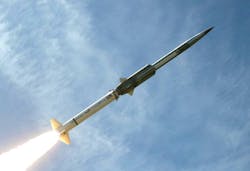PATUXENT RIVER NAS, Md. — The Northrop Grumman Innovation Systems segment (formerly Orbital ATK) in Dulles, Va., are building supersonic target drones for the U.S. Navy and Army to help hone missile-defense skills and technologies.
U.S. Naval Air Systems Command at Patuxent River Naval Air Station, Md., announced a $46.5 million order to Northrop Grumman in December to build 15 GQM-163A lot 13 Coyote sea-skimming target base vehicles — 14 for the U.S. Navy and one for the Army.
The GQM-163A Coyote sea-skimming supersonic target drone will help surface warship crews practice how to detect and defeat incoming anti-ship missiles.
The Navy will use the supersonic target drones to help surface warship crews practice how to detect and defeat incoming anti-ship missiles. The Army, meanwhile, will use its Coyote to test and evaluate the Lower Tier Air and Missile Defense Sensor (LTAMDS) limited user test target system.
The target drone could help surface warship crews and land-based counter-missile battery crews learn to fight effectively against a new generation of hypersonic cruise missiles that could reach speeds of Mach 5 or faster.
GQM-163A Coyote is a non-recoverable, supersonic aerial target, capable of speeds of Mach 2 or greater and altitudes from 13 to 66 feet above the surface of the ocean. It flies faster than twice the speed of sound, and as low as 12 feet off the surface of the ocean. The target drone also can simulate high-altitude cruise missile attacks that plunge down at ships from higher than 30,000 feet.
On this order Northrop Grumman Innovation Systems will do the work in Chandler, Ariz.; Camden, Ark.; Vergennes, Vt.; Lancaster, Pa.; and Hollister, Calif.; and should be finished by December 2022.
For more information contact Northrop Grumman Innovation Systems online at www.northropgrumman.com, or Naval Air Systems Command at www.navair.navy.mil.

